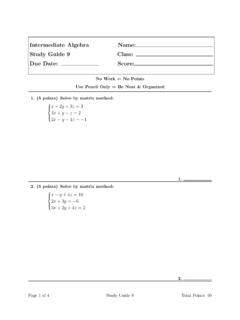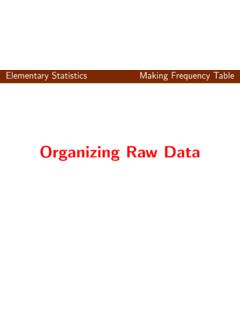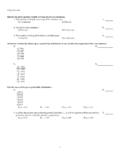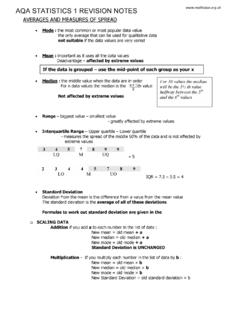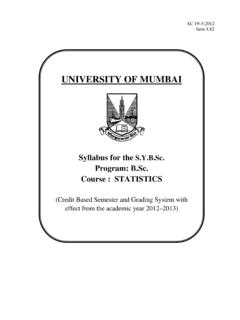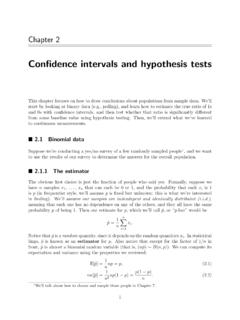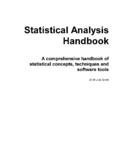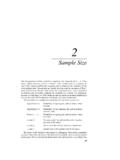Transcription of Chapter 8 Overview - MyMathClasses
1 1 Slide 1 Copyright 2004 Pearson Education, 8 Hypothesis Testing8-1 Overview8-2 Basics of Hypothesis Testing8-3 Testing a Claim About a Proportion8-4 Testing a Claim About a Mean: Known8-5 Testing a Claim About a Mean: Not Known8-6 Testing a Claim About a Standard Deviation or VarianceSlide 2 Copyright 2004 Pearson Education, In statistics, a hypothesisis a claim or statement about a property of a population. A hypothesis test(or test of significance) is a standard procedure for testing a claim about a property of a 3 Copyright 2004 Pearson Education, Hypothesis: H0 The null hypothesisincludes the assumed value of the population parameter. It must be a statement of equality. Test the Null Hypothesis directly RejectH0or fail to rejectH0 Components of aFormal Hypothesis TestSlide 4 Copyright 2004 Pearson Education, Hypothesis: H1 The alternative hypothesis(denoted by H1or Ha) is the statement that the parameter has a value that somehow differs from the null hypothesis.
2 , <, >Components of aFormal Hypothesis TestSlide 5 Copyright 2004 Pearson Education, about Forming Your Own Claims (Hypotheses)If you are conducting a study and want to use a hypothesis test to supportyour claim, the claim must be worded so that it becomes the alternative 6 Copyright 2004 Pearson Education, about Identifying H0and H1 Figure 7-22 Slide 7 Copyright 2004 Pearson Education, : Identify the Null and Altenative Hypothesis. Refer to Figure 7-2 and use the given claims to express the corresponding null and alternative hypotheses in symbolic ) The proportion of drivers who admit to running red lights is greater than Step 1 of Figure 7-2, we express the given claim as p > In Step 2, we see that if p> is false, then p must be true. In Step 3, we see that the expression p> does not contain equality, so we let the alternative hypothesis H1be p> , and we let H0be p= 8 Copyright 2004 Pearson Education, TestPoints Right01.
3 5 >Slide 9 Copyright 2004 Pearson Education, : Identify the Null and Altenative Hypothesis. Refer to Figure 7-2 and use the given claims to express the corresponding null and alternative hypotheses in symbolic ) The mean height of professional basketball players is at least 6 Step 1 of Figure 7-2, we express a mean of at least 6 ft in symbols 6. In Step 2, we see that if 6 is false, then < 6 must be true. In Step 3, we see that the expression < 6 does not contain equality, so we let the alternative hypothesis H1be <6, and we let H0be 10 Copyright 2004 Pearson Education, TestPoints Left01:6:6HH =<Slide 11 Copyright 2004 Pearson Education, : Identify the Null and Altenative Hypothesis. Refer to Figure 7-2 and use the given claims to express the corresponding null and alternative hypotheses in symbolic ) The standard deviation of IQ scores of actors is equal to 15.
4 In Step 1 of Figure 7-2, we express the given claim as = 15. In Step 2, we see that if = 15 is false, then 15 must be true. In Step 3, we let the alternative hypothesis H1be 15, and we let H0be = 12 Copyright 2004 Pearson Education, Test is divided equally between the two tails of the critical regionless than or greater than01:15:15HH = 3 Slide 13 Copyright 2004 Pearson Education, test statisticis a value computed from the sample data, and it is used in making the decision about the rejection of the null StatisticTest statistic for proportion ppzpqn =Slide 14 Copyright 2004 Pearson Education, test statisticis a value computed from the sample data, and it is used in making the decision about the rejection of the null StatisticTest statistic for meanxzn =When is knownSlide 15 Copyright 2004 Pearson Education, test statisticis a value computed from the sample data, and it is used in making the decision about the rejection of the null StatisticTest statistic for meanxtsn =When is unknownSlide 16 Copyright 2004 Pearson Education, test statisticis a value computed from the sample data.
5 And it is used in making the decision about the rejection of the null Statistic 2=(n 1)s2 2 Test statistic for standard deviationSlide 17 Copyright 2004 Pearson Education, RegionThe critical region(or rejection region) is the set of all values of the test statistic that cause us to reject the null hypothesis. For example, see the red-shaded region in Figure 18 Copyright 2004 Pearson Education, LevelThe significance level(denoted by ) is the probability that the test statistic will fall in the critical region when the null hypothesis is actually true. This is the same introduced in Section 6-2. Common choices for are , , and 19 Copyright 2004 Pearson Education, ValueA critical valueis any value that separates the critical region (where we reject the null hypothesis) from the non-critical region which is determined by the value of the significance level.
6 Slide 20 Copyright 2004 Pearson Education, P-value(or p-valueor probabilityvalue) is the probability of getting a value of the test statistic that is at leastas extremeas the one representing the sample data, assuming that the null hypothesis is true. Slide 21 Copyright 2004 Pearson Education, to find P-valuesFigure 7-6 Slide 22 Copyright 2004 Pearson Education, in Hypothesis Testing We always test the null Reject the H02. Fail to rejectthe H0 Slide 23 Copyright 2004 Pearson Education, method: Reject H0if the test statistic falls within the critical to reject H0 if the test statistic does not fall within the critical CriterionSlide 24 Copyright 2004 Pearson Education, method: Reject H0if P-value .Fail to reject H0 if P-value > .Decision Criterion5 Slide 25 Copyright 2004 Pearson Education, option: Instead of using a significance level such as , simply identify theP-value and leave the decision to the CriterionSlide 26 Copyright 2004 Pearson Education, of Final ConclusionFigure 7-7 Slide 27 Copyright 2004 Pearson Education, versus Fail to Reject Some texts use accept the null hypothesis.
7 We are not proving the null hypothesis. The sample evidence is not strong enough to warrant rejection (such as not enough evidence to convict a suspect).Slide 28 Copyright 2004 Pearson Education, I & IIError A Type I erroris the mistake of rejecting the null hypothesis when it is true. The symbol (alpha) is used to represent the probability of a type I error. A Type II erroris the mistake of failing to reject the null hypothesis when it is false. The symbol (beta) is used to represent the probability of a type II 29 Copyright 2004 Pearson Education, : Assume that we a conducting a hypothesis test of the claim p> Here are the null and alternative hypotheses: H0: p= , and H1: p> ) A type I error is the mistake of rejecting a true null hypothesis, so this is a type I error: Conclude that there is sufficient evidence to support p> , when in reality p= ) A type II error is the mistake of failing to reject the null hypothesis when it is false, so this is a type II error: Fail toreject p= (and therefore fail to support p> ) when in reality p> 30 Copyright 2004 Pearson Education, 31 Copyright 2004 Pearson Education, Type Iand Type IIErrors For any fixed , an increase in the sample size nwill cause a decrease in.
8 For any fixed sample size n, a decrease in will cause an increase in . Conversely, an increase in will cause a decrease in . To decrease both and , increase the sample 32 Copyright 2004 Pearson Education, for Testing Claims About a Population Proportion p1) The sample observations are a simple random ) The conditions for a binomial experiment are satisfied (Section 4-3)Slide 33 Copyright 2004 Pearson Education, ) The sample observations are a simple random ) The conditions for a binomial experiment are satisfied (Section 4-3)3) The condition np 5 and nq 5 are satisfied, so the binomial distribution of sample proportions can be approximated by a normal distribution with = npand = npq .Assumptions for Testing Claims About a Population Proportion pSlide 34 Copyright 2004 Pearson Education, population proportion (used in the null hypothesis)q= 1 pn= number of trials(sampleproportion) xpn=Slide 35 Copyright 2004 Pearson Education, Inc.
9 (determining the sample proportion of households with cable TV)psometimes is given directly 10% of the observed sports cars are red is expressed as p= must be calculated 96 surveyed households have cable TVand 54 do not is calculated usingp = = = (96+54) Slide 36 Copyright 2004 Pearson Education, : In the Chapter Problem, we noted that an article distributed by the Associated Press included these results from a nationwide survey: Of 880 randomly selected drivers, 56% admitted that they run red lights. The claim is that the majority of all Americans run red lights. That is, p> The sample data are n= 880, and p = np= (880)( ) = 440 5nq= (880)( ) = 440 5and 880(.56) 493xnp=== 7 Slide 37 Copyright 2004 Pearson Education, Inc. H0: p= : p> = pz= ( )( )880== : In the Chapter Problem, we noted that an article distributed by the Associated Press included these results from a nationwide survey: Of 880 randomly selected drivers, 56% admitted that they run red lights.
10 The claim is that the majority of all Americans run red lights. That is, p> The sample data are n= 880, and p= We will use the Traditional is a right-tailed test, so the critical region is an area of We find that z= is the critical value of the critical region. We reject the null is sufficient evidence to support the 38 Copyright 2004 Pearson Education, : In the Chapter Problem, we noted that an article distributed by the Associated Press included these results from a nationwide survey: Of 880 randomly selected drivers, 56% admitted that they run red lights. The claim is that the majority of all Americans run red lights. That is, p> The sample data are n= 880, and p= We will use the P-value Method. H0: p= : p> = pz= ( )( )880== to Table A-2, we see that for values of z= and higher, we use for the cumulative area to the left of the test statistic.

